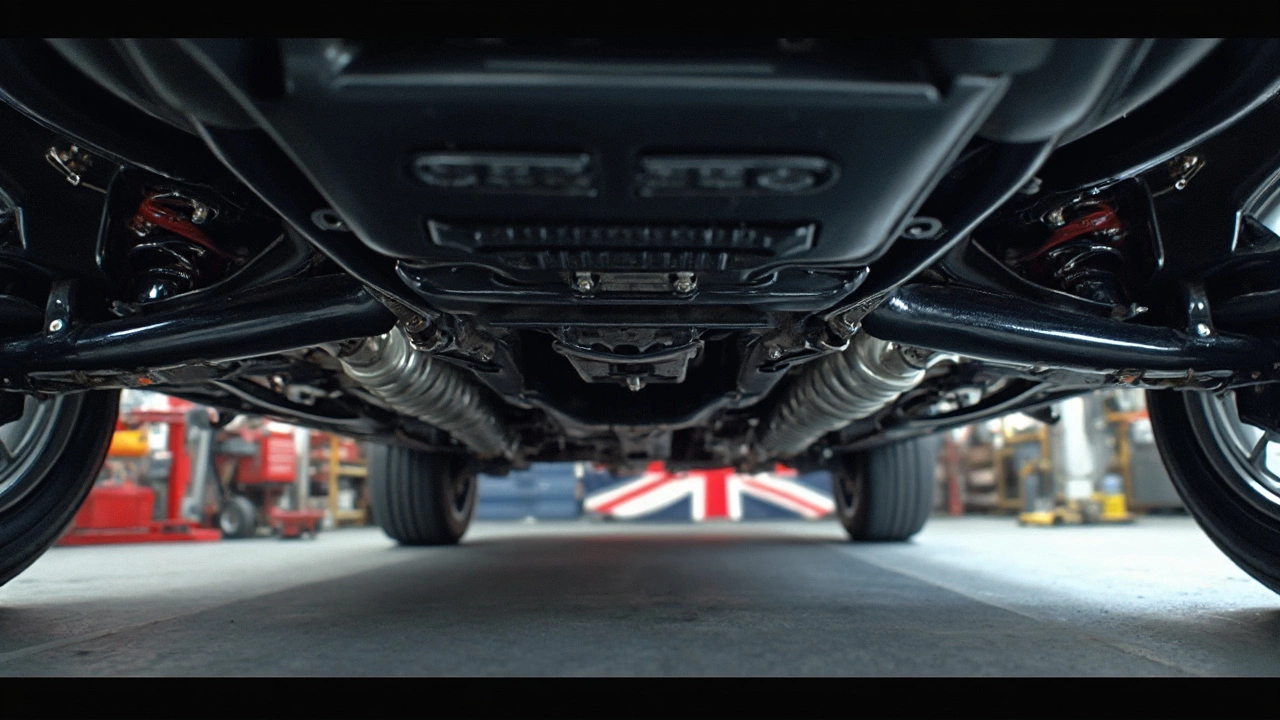So, you're cruising along in your car, but something feels off. Maybe your ride is bumpier than an old-school rollercoaster, or your handling is as sloppy as a novice dog walker with ten leashes. Either way, your front suspension might be begging for some love and attention.
Upgrading your front suspension could change your whole driving game. It's not just about smoothing out those pesky potholes—it's about control, safety, and a little bit of that ‘wow’ factor when you zoom out of the garage. The good news? You don't need to be a certified mechanic to make it happen.
- Understanding Front Suspension Basics
- Signs It's Time for an Upgrade
- Picking the Right Parts
- Installation Tips and Tricks
Understanding Front Suspension Basics
Diving into the world of front suspension might feel like peeking under a mysterious hood, but it’s actually straightforward once you've got the basics down. The front suspension is a complex system made up of several key parts that all work together to make your ride smoother and handle better.
At its core, the front suspension is designed to maximize the friction between the tires and the road, ensuring that you have stable steering and comfortable handling. The main components you're dealing with are the coil springs, shock absorbers, and control arms. Each plays a vital role in how your car feels and performs on the road.
- Coil Springs: These act like the bouncers of your suspension system. They compress and expand to absorb shocks from bumps and dips.
- Shock Absorbers: Often called shocks, these work hand in hand with the springs to dampen the motion, ensuring your car doesn’t just keep bouncing around like it's on a trampoline.
- Control Arms: These connect your wheels to the car and help them move up and down in a controlled manner. Think of them as the suspension’s translators, communicating what’s happening on the ground to the rest of the car.
Now, here’s a fun fact: the quality of your front suspension directly impacts braking efficiency. A well-maintained system can improve your stopping power, helping you steer clear of accidents.
Ensuring you understand these components is the first step to knowing when they might need an upgrade. Don't wait until the ride starts feeling like you're driving on cobblestones—keeping an eye on these parts can save you time and money down the road.
Signs It's Time for an Upgrade
How do you know when your car's front suspension is throwing in the towel? Well, there are a few telltale signs that your ride might be ready for some TLC. Ignoring these hints could lead to bigger problems down the road, so let's dive into what to watch for.
First up, if your car feels like it's bouncing more than a toddler on a trampoline after hitting bumps, that's a classic indicator. This could mean your shocks or struts need replacing. They play a crucial role in keeping your suspension system tight and responsive.
Another biggie is uneven tire wear. Take a look at your tires. Are they wearing down more in some spots than others? This could point to a suspension system that's not holding things steady. Proper alignment is key for both safety and longevity.
Have you noticed your car pulling to one side? That's not a ghost at the wheel—it's likely your suspension system making an unscheduled visit to wobbly town. It’s a clear sign that it’s time to check your alignment and other suspension components.
Here’s a simple DIY check you can do: the bounce test. Give your car’s front end a solid push downwards. If it bounces more than twice, those shock absorbers might be saying they're done for.
- Excessive bounce over bumps
- Uneven tire wear
- Vehicle pulling to one side
- Rigorous bouncing when pushed
Also, listen for odd noises like clunking or squeaking when you're driving. These sounds are often your car’s way of yelling for help.
If you're seeing or feeling any of these signs, it might be time to consider an upgrade. Not only will it improve handling and safety, but enhancing your front suspension can make driving a lot more enjoyable.

Picking the Right Parts
Deciding to boost your front suspension is a great move, but where do you even start? Picking the right parts can feel like a maze of options, making even the simplest decision seem complicated. Let's break it down so you know what to look for.
First off, let's talk shocks and struts. These are the stars of your car's suspension show. If you've been feeling every bump and pothole, swapping in some new shocks could be the solution. What you want are high-quality, durable shocks that can handle your driving style and conditions. Brands like Bilstein and KYB are well-known for their reliability and performance.
Next up, consider coil springs. They're essential for maintaining ride height and overall comfort. If you're aiming for better performance, you might want to pair your new shocks with performance springs. Progressive springs, for instance, can give you a softer ride on city roads while stiffening up for those tight corners.
Thinking about stability? Don't skip out on the sway bars. These help in reducing body roll during turns, giving you a more stable and controlled ride. Upgraded sway bars can make your car feel more like a precision tool than a wobbly cart. It’s an often-overlooked upgrade but can make a big difference.
If you're a data geek like me, consider the numbers. Based on customer reviews, upgraded suspension components can improve handling by up to 30% compared to stock parts. Not just that, they can improve tire wear, saving you cash in the long run.
| Suspension Part | Estimated Improvement |
|---|---|
| Shocks and Struts | 20% better ride quality |
| Coil Springs | 30% improved comfort |
| Sway Bars | 25% less body roll |
Remember, stick to parts compatible with your specific car model. Consult your car's manual or chat with someone at your local auto shop for specs. This ensures a perfect fit and optimal performance without headaches down the road.
To sum it up, upgrading your front suspension isn't just about swapping parts—it's about tailoring your ride to fit you. Dive into the options, consider your driving habits, and enjoy the smoother, more controlled ride you've been craving.
Installation Tips and Tricks
Alright, so you're ready to dive into upgrading that front suspension. You've got the parts, the motivation, and maybe even a buddy lined up to lend a helping hand. Let's make sure everything goes as smoothly as possible, so you don't end up with nuts and bolts left over—trust me, that's never a good sign.
First things first, make sure you're working in a safe and well-lit space where you can easily get around the car. Safety goggles, gloves, and some sturdy stands for your vehicle are a must. You wouldn’t want Clyde, my over-inquisitive dog, to meander around playing with car parts, trust me!
- Lift the Car: Start by securely lifting your car using a hydraulic jack and placing jack stands under the car's frame for extra support. This gives you the necessary room to work and prevents any mishaps.
- Remove the Wheel: Unbolt the wheel to access the suspension system. A good impact wrench can make this job quicker and less muscle-intensive.
- Detach Old Components: You’ll need to remove the existing suspension parts like struts and bearings. Keep an eye on how everything fits together; taking some photos during each step isn’t a bad idea.
- Install New Parts: Place the new components exactly as the old ones were. You might need to knead the parts a bit to fit, but don't force anything too hard—patience is key. Pay special attention if you’re upgrading; sometimes, new parts require slight modifications.
- Tighten Everything Up: Make sure to bolt everything securely to avoid any rattling. Be particularly alert to any service manual-specific torque specs; tighter is not always better.
- Double-Check: Once installed, give everything a final inspection to make sure each piece is in its proper place and tightly secured.
Before you take your newfound pride and joy back on the road, test everything in a controlled environment. Drive slowly in an empty parking lot to check how the car responds—braking, turning, and accelerating. That’ll help make sure your car suspension improves driving experience and doesn't just look good on paper.
Wondering if you're the only one who occasionally struggles? You’re not alone. According to a recent DIY car enthusiasts' survey, nearly 35% of individuals admitted reinstalling the suspension due to improper initial installation. So, triple-check your work, follow these steps, and let your car glide smoothly, every bump making you smile instead of grimace!

